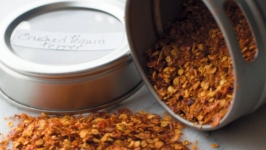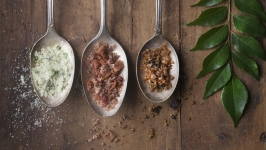Fresh-Grown Herbs: A healthy dose of flavour
There’s a lot of interest in the medicinal wonders of herbs, from echinacea for boosting immunity to milk thistle for its anti-in-flammatory properties. These superstars are even readily available in handy forms—such as oral supplements and tea—for easy consumption when an ailment hits.
Convenient, yes—but these packaged goods are missing some benefits that fresh herbs bring to the table and garden. For home cooks, freshly grown herbs are not only healthy, but they also offer a flavor boost that can transform a dish, punch up a menu and elevate an everyday meal. For the gardener, herbs add beauty, fragrance and seasonal interest to small beds or pots, and can fill up the blank spaces in a yard with their fast growth and tendency to reseed.
Regarding health benefits, research indicates herbs are the real deal. Loaded with protective polyphenols—compounds that have antioxidant properties—consuming herbs can move our bodies away from inflammation and disease and toward healing and vitality. Scientists now believe that long-term consumption of diets rich in plant polyphenols offers protection against development of cancers, cardiovascular diseases, diabetes, osteoporosis and neurodegenerative diseases.
Lucky for us, the Bay Area’s mild winters and long growing season offer a year-round source of locally grown herbs. Here are some of the healthiest, easiest to grow and tastiest to inspire your meals.
Basil
Basil (Ocimum basilicum) is synonymous with California summers and will grow happily in a pot or garden patch, sprouting new leaves almost continually for months. As a medicinal herb, basil aids in digestion, offers anti-inflammatory, antimicrobial and antibacterial properties and has shown to protect against some carcinogen-induced cancers in mice. Try unusual varietals, like Boxwood Basil, which sprouts massive amounts of tiny leaves without woody stems, or the purple flowers of Thai Basil, which add a spicy, anise-like flavor to dishes. Holy Basil, or Tulsi, with its clove-like fragrance, is usually brewed as a tea and offers great potential as a stress and cortisol reducer.
How to use: What isn’t good with basil? A natural friend to any tomato dish, try mixing a basil purée into mashed potatoes, add it pesto or salsa verde, toss whole leaves in salads and sandwiches, or steep it with olive oil for a bright green, summer-scented condiment.
Bay Leaves
Bay leaves (Laurus nobilis) grow on a sturdy bush that can be pruned into a tidy hedge or trained into a small tree. It provides a striking focal point in a pot on a porch or patio with shiny leaves that stay verdant green, year round. Its leaves are loaded with unique enzymes that help facilitate efficient digestion and nutrient intake, and provide relief from cramping, bloating and gas. (While many trees fall under the category of “bay leaf ” only the leaves from the Laurus nobilis variety can be ingested).
How to use: Add to stews and soups for a fresh, aromatic flavor or brew as a tea, with a spoonful of sugar, to help with nausea and indigestion.
Oregano
Oregano (Origanum vulgare) might be the king of herbs in terms of health benefits, with higher antioxidant activity than many culinary and medicinal herbs and fruits and vegetables. It’s rich in rosmarinic acid and thymol, two powerful antioxidant compounds that are closely linked to reducing oxidative stress in the body. Good news for Bay Area cooks: Oregano grows and spreads prolifically—invasively in some cases—and can be cut back, only to produce more tender green leaves. A four-inch plant can yield a constant supply of the herb in the warm months and might be best relegated to its own pot or bed.
How to use: The herb goes in almost any Mediterranean or Mexican dish, and is more strongly flavored when dried than fresh. Don’t worry—the health benefits are even more pronounced in the dried herbs as the drying process concentrates the polyphenols.
Cayenne And Chiles
Turns out that a spicy life is a healthy life. New research confirms what many ancient cultures already know: Hot peppers, including cayenne (Capsicum annuum) and chilis, are loaded with anti-inflammatory properties, can aid digestion and relieve chronic pain. Scientifically, chilis are a concentrated source of capsaicin, a powerful phytochemical that gives the plant its heat and protects it from disease—and may extend those protective properties to humans. Data suggests chili capsaicinoids target a variety of pathways involved in cancer development and inflammation.
How to use: Use chili like salt—it infuses a punch of warmth into just about anything, savory or sweet. Add a pinch of chili flakes to pasta sauce, stir ground cayenne into hot cocoa, dust roasted nuts with ancho powder and cinnamon or float rounds of fresh hot peppers in pho or soup. For cold season, boost your immunity with a cup of “tea” by combining cayenne, lemon juice and honey with hot water.
Lavender
Once reserved for soaps and fragrances, the world has gone mad for lavender as a flavor agent. From lavender honey to scented ice cream and tea, the pungent purple buds reduce stress and muscle tension and have anti-inflammatory, anti-fungal and antiseptic capabilities. English Lavender (Lavandula angustifolia) and the French Provence are the most fragrant and best for cooking. The plants bloom profusely in early summer but can be harvested and dried for year-round use. Lucky us—lavender plants are drought tolerant and will often bloom twice in California’s long, dry, hot summers.
How to use: Try lavender in savory roasted meats, such as lamb or pork. Throw a handful of dried flowers on your wood-fired grill or use branches to baste meats and veggies, much as you would rosemary.





